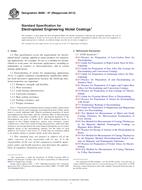Potrebujeme váš súhlas na využitie jednotlivých dát, aby sa vám okrem iného mohli ukazovať informácie týkajúce sa vašich záujmov. Súhlas udelíte kliknutím na tlačidlo „OK“.
ASTM B920-01(2011)
Standard Practice for Porosity in Gold and Palladium Alloy Coatings on Metal Substrates by Vapors of Sodium Hypochlorite Solution
Automaticky preložený názov:
Štandardné praktiky pre Pórovitosť v zlate a Palladium Alloy povlakov na kovové podklady o par roztoku chlórnanu sodného
NORMA vydaná dňa 1.10.2011
Informácie o norme:
Označenie normy: ASTM B920-01(2011)
Poznámka: NEPLATNÁ
Dátum vydania normy: 1.10.2011
Kód tovaru: NS-8797
Počet strán: 4
Približná hmotnosť: 12 g (0.03 libier)
Krajina: Americká technická norma
Kategória: Technické normy ASTM
Kategórie - podobné normy:
Anotácia textu normy ASTM B920-01(2011) :
Keywords:
electrical contacts, gold coatings, gold platings, hypochlorite, palladium coatings, palladium platings, plated contacts, plating porosity, pore corrosion test, pore counting, porosity screen testing, porosity testing: Electrodeposited Pd coatings--specifications, Electrodeposited gold coatings, Hypochlorite solutions, Palladium alloy electrical contact materials, Plating porosity, Porosity--electrodeposited/metallic coatings, Sodium hypochlorite solutions
Doplňujúce informácie
| Significance and Use | ||||||||||||||||
|
Palladium and gold coatings are often specified for the contacts of separable electrical connectors and other devices. Electrodeposits are the form of gold that is most used on contacts, although it is also employed as inlay or clad metal and as weldments on the contact surface. The intrinsic nobility of gold and palladium alloys enables it to resist the formation of insulating oxide films that could interfere with reliable contact operation. In order for these coatings to function as intended, porosity, cracks, and other defects in the coating that expose base-metal substrates and underplates must be minimal or absent, except in those cases where it is feasible to use the contacts in structures that shield the surface from the environment or where corrosion inhibiting surface treatments for the deposit are employed. The level of porosity in the coating that may be tolerable depends on the severity of the environment to the underplate or substrate, design factors for the contact device like the force with which it is mated, circuit parameters, and the reliability of contact operation that it is necessary to maintain. Also, when present, the location of pores on the surface is important. If the pores are few in number and are outside of the zone of contact of the mating surfaces, their presence can often be tolerated. Methods for determining pores on a contact surface are most suitable if they enable their precise location and numbers to be determined. Contact surfaces are often curved or irregular in shape, and testing methods should be suitable for them. In addition, the severity of porosity-determining tests may vary from procedures capable of detecting all porosity to procedures that detect only highly porous conditions. The present test practice is capable of detecting virtually all porosity or other defects that could participate in corrosion reactions with the substrate or underplate. In addition, it can be used on contacts having complex geometry such as pin-socket contacts (although with deep recesses it is preferred that the contact structures be opened to permit reaction of the vapors with the interior significant surfaces). The relationship of porosity levels revealed by particular tests to contact behavior must be made by the user of these tests through practical experience or by other forms of testing. Thus, absence of porosity in the coating may be a requirement for some applications, while a few pores in the contact zone may be acceptable for others. The acceptable number, sizes and locations of the pore corrosion products shall be as specified on the appropriate drawing or specification. This test is considered destructive in that it reveals the presence of porosity by contaminating the surface with corrosion products and by undercutting the coating at pore sites or at the boundaries of the unplated areas. Any parts exposed to this test shall not be placed in service. The test is simple and inexpensive. The cost associated with the test is very low, using standard basic equipment found in an industrial laboratory. There are minimal waste disposal issues associated with the procedure. The test is very popular because of its very quick means of assessing the likelihood of plating quality problems, prior to the performance of accelerated environmental testing on the 1 to 2 week scale at much greater expense. |
||||||||||||||||
| 1. Scope | ||||||||||||||||
|
1.1 This test practice covers equipment and methods for revealing the porosity of gold and palladium coatings, particularly electrodeposits and clad metals used on electrical contacts. 1.2 This test practice is suitable for coatings containing gold or 75 % by mass of palladium on substrates of copper, nickel, and their alloys, which are commonly used in electrical contacts. 1.3 A variety of full porosity testing methods is described in the literature. , These porosity Test Methods are B735, B741, B798, B799, and B809. An ASTM Guide to the selection of porosity tests for electrodeposits and related metallic coatings is available as Guide B765. 1.4 The values stated in SI units are to be regarded as standard. The values given in parentheses are for information only. 1.5 This standard does not purport to address all of the safety concerns, if any, associated with its use. It is the responsibility of the user of this standard to establish appropriate safety and health practices and determine the applicability of regulatory limitations prior to use. For specific hazards, see Section 6. |
||||||||||||||||
| 2. Referenced Documents | ||||||||||||||||
|
Podobné normy:
Historická
1.11.2010
Historická
1.9.2009
Historická
15.4.2009
Historická
1.12.2013
Historická
1.9.2009
Historická
1.4.2010
Odporúčame:
Aktualizácia zákonov
Chcete mať istotu o platnosti využívaných predpisov?
Ponúkame Vám riešenie, aby ste mohli používať stále platné (aktuálne) legislatívne predpisy
Chcete vedieť viac informácií ? Pozrite sa na túto stránku.



 ASTM B651-83(2010)..
ASTM B651-83(2010).. ASTM B679-98(2009)..
ASTM B679-98(2009).. ASTM B680-80(2009)..
ASTM B680-80(2009).. ASTM B689-97(2013)..
ASTM B689-97(2013).. ASTM B696-00(2009)..
ASTM B696-00(2009).. ASTM B697-88(2010)..
ASTM B697-88(2010)..
 Cookies
Cookies
